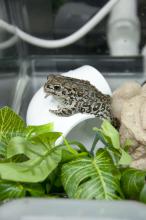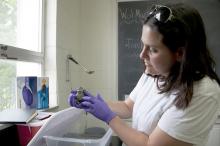Information Possibly Outdated
The information presented on this page was originally released on May 8, 2012. It may not be outdated, but please search our site for more current information. If you plan to quote or reference this information in a publication, please check with the Extension specialist or author before proceeding.
MSU working to increase endangered toad numbers
MISSISSIPPI STATE – Plastic storage crates in a sunny lab at Mississippi State University are the new homes of 52 endangered Boreal toads, native to the Colorado Rockies.
Boreal toad numbers have dwindled to dangerous levels in recent years, and MSU has partnered with the Memphis Zoo to find a way to increase the population.
Nat Calatayud, a post-doctoral fellow from Mexico who earned her doctoral degree in Australia in marsupial reproduction, is working on the project. She is under the supervision of Scott Willard, head of MSU’s Department of Biochemistry and Molecular Biology, Entomology and Plant Pathology, and Andy Kouba of the Memphis Zoo.
“We’re trying to optimize the reproduction protocols for these toads,” Calatayud said. “We want to get the toads to reproduce in captivity so the young can be raised and released to the wild.”
There is a large Boreal toad population in the wild in Alamosa, Colo., but those in captivity there don’t reproduce as prolifically. Those in captivity in the South don’t breed at all.
“In Colorado, they usually hibernate naturally from November to summer, and this is believed to be a major trigger of their reproductive cycle,” Calatayud said. “Here, we do not hibernate them in the lab.”
Working with Calatayud are Cecilia Langhorne, a doctoral student in physiology from Scotland; and Trish Rowlison, a master’s student in physiology from Missouri.
“We are trying to figure out what hormones to use to get the Boreal toads to reproduce in captivity without hibernation,” Langhorne said. “We’re trying to override hibernation and use hormones to induce breeding, but this is proving to be a fine science.”
The toads look very similar to Mississippi-native Fowler toads, but they have a few differences. For one thing, Boreal toads are sluggish when compared to their Mississippi cousins.
Calatayud can turn her back on a toad resting on a lab bench without fear the toad will escape. Fowler toads are quick to hop away when presented the opportunity.
Boreal toads have the distinctive warts toads are known for, but their feet are more webbed than those of a Fowler toad. The amphibians come in a range of shades of gray, brown, black and green. They even can change color slightly to match their environment.
Unlike Mississippi Fowler toads, which have a call, Boreal toads are silent except for a slight chirp when they are picked up. They also have a long natural lifespan in Colorado. One toad found in the wild in 2011 had been tagged in 1995.
Their bellies make them unique. Three to four toads live in each plastic toad habitat, complete with a pool area, sand beach and artificial cave. Belly pictures, along with their names, are posted on the side of each plastic crate to help with identification.
“The underside of a toad is like a thumbprint on a human,” Calatayud said. “It’s how we identify them. No two are alike.”
To show just how distinctive they are, each toad has been given a name. Visitors to the toad lab can meet Diane, Beyoncé, Linus, Zsa Zsa and Elvis, who has definitely not left the building.
The Boreal toads eat a typical toad diet of mealworms, crickets and wax worms. In the winter, they eat twice a week, but in warmer weather, they are fed three times a week.
Calatayud, Langhorne and Rowlison, along with master’s graduate Lindsay Bullock from Ripley, care for the toads and conduct research on Assisted Reproductive Technologies, or ART. Right now, they are tracking hormone levels in the toads.
“It’s a bit hard to draw a blood sample from a toad, so we get them to pee in a dish each day, and we test the hormones found in the urine,” Calatayud said.
Toads urinate on nearly every child who picks one up at home, so the process of getting a toad to pee is not very scientific. The researchers gently hold the toad under the armpits and stroke its belly while it is suspended over a Petrie dish.
At one time, the lab was collecting urine samples from all 52 toads a day, but now they collect samples twice a month from the entire population and daily from a much smaller group.
Kouba, director of conservation and research at the Memphis Zoo, said the partnership between MSU and the zoo has been a great program for both institutions, creating new graduate student and post-doctoral fellowship positions to address critical areas of conservation for declining populations.
“Advances in biochemistry, molecular biology and cryobiology are being applied to saving amphibians, like the Mississippi gopher frog, a locally endangered species that is relying upon MSU studies for its long-term genetic management and survival,” Kouba said.
This program is funded by two Institute of Museum and Library Services grants and a Morris Animal Foundation grant.
“By working together on these programs, the Memphis Zoo and MSU are able to combine resources and expertise to create a unique learning environment for future scientists interested in various disciplines related to conservation ecology,” Kouba said. “Thanks to passionate scientists like Nat, Cecilia and Tricia, I am encouraged that there is a more hopeful future for threatened amphibians.”





